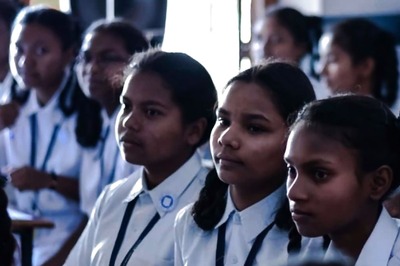
views
The regional political parties of Bihar fought the 2020 state assembly elections as part of one alliance or the other and reaped varied electoral fortunes. Most of them have now set their destination to Kolkata to try their luck independently in the ensuing West Bengal polls.
Interestingly, the parties that contested together as allies in Bihar will be pitted against each other as rivals in Bengal. Some of them are trying to forge alliances with West Bengal-based parties while others have extended unflinching support to the party or coalition of their choice.
However, their electoral foray into West Bengal does not promise much electoral gain in terms of seats given the cut-throat contest the state is set to witness between the belligerent Bharatiya Janata Party (BJP) and the unrelenting Trinamool Congress (TMC) chief Mamata Banerjee, who is not ready to give in without a tooth-and-nail fight.
For the regional parties of Bihar, the entry into Bengal politics is mainly aimed at garnering some votes to expand their base and gaining some seats unexpectedly in multi-cornered fights. Their main strategy is to cash in on the voters of Bihar origin settled in Kolkata and in the areas contiguous to the Bihar border.
The parties readying to test the electoral waters of Bengal are the Janata Dal (United), Lok Janshakti Party (LJP) and Hindustani Awam Morcha (HAM). Besides, the All India Majlis-e-Ittehadul Muslimeen (AIMIM) is making inroads, taking into account the substantial population of Muslims in West Bengal, especially in the areas bordering Bangladesh.
The Rashtriya Janata Dal (RJD) initially tried to explore the possibilities of contesting elections but it later realised the mood of the people and announced support to the Trinamool Congress. RJD leader Tejashwi Prasad Yadav, after his meeting with Mamata Banerjee recently, has urged his supporters in Bengal to back TMC candidates in the elections.
The incarcerated RJD president Lalu Prasad has also batted for Mamata, underlining that it was needed to “protect democratic values” and “uphold politics based on principles” in the country.
In the 2015 Bihar elections, Mamata Banerjee had extended moral support to the RJD-Congress-JD (U) coalition. The RJD had also won a seat in West Bengal in the 2006 assembly elections as part of the Left Front alliance.
The RJD has announced to contest the Assam polls with ‘like-minded’ parties. It is in talks with the Congress and AIUDF led by Lok Sabha MP Badruddin Ajmal to firm up the pre-poll alliance.
For Bihar’s ruling JD (U), the electoral forays in West Bengal and Assam are not only aimed at gaining votes and testing its popularity but it is also a message to the BJP, which has assimilated its six-member legislature party in Arunachal Pradesh. The JD (U) has decided to go it alone and face the BJP on nearly 25 seats in West Bengal and over 30 assembly seats in Assam.
In Assam, the JD (U) has identified constituencies like Moregaon, Navgain, Samaguri, Ruphar and Laharighat with substantial presence of Hindi-speaking people from Bihar besides the Muslims.
The LJP, which was vanquished in the 2020 Bihar elections, has declared to field candidates in all 294 assembly seats in Bengal. In the 2016 assembly polls, the LJP had contested 63 assembly seats including two transgender candidates – Bobby Halder against Mamata Banerjee from Bhawanipore and Shankari Mandal from the Jadavpur seat.
Emboldened by its electoral performance in Bihar, where it won five seats in the eastern part of Bihar, the AIMIM is trying to make a dent in Bengal politics. AIMIM chief Asaduddin Owaisi had formed an alliance with Furfura Sharif cleric Abbas Siddiqui to field candidates in the upcoming polls. However, Abbas has floated the Indian Secular Front and is now hobnobbing with the Congress-Left alliance to influence the Muslim votes against Mamata Banerjee.
Former Bihar chief minister Jitan Ram Manjhi, who heads HAM, has also announced that his party would contest on 26 seats in Bengal. Manjhi has already visited Bengal once to explore the seats where the party can contest successfully.
The TMC chief has requested Jharkhand chief minister Hemant Soren to campaign for her in West Bengal. The Jharkhand Mukti Morcha (JMM), which is in alliance with the Congress in Jharkhand, has not yet decided but the party intends to stall the BJP’s perceived ascendancy in West Bengal. The final decision will be taken soon by JMM patriarch Shibu Soren.
A large number of people from Jharkhand are engaged gainfully in the tea gardens of Bengal and Assam. In fact, the JMM had demanded the inclusion of some areas of West Bengal, Bihar and Odisha at the time of the creation of Jharkhand in 2000.
Though the Bihar-based parties are trying to make their presence felt on the electoral ground in West Bengal, it is anticipated that they will only spoil the chances of the TMC and the BJP. For, such small parties do not enjoy much political clout in Bengal barring certain assembly constituencies in the areas bordering Bihar where they have a sizable influence.
According to the Census, nearly 45 lakh Hindi-speaking people from Bihar and Uttar Pradesh live in different parts of Bengal and they are usually wooed by the BJP. The Trinamool Congress claims its edge in nearly 60 assembly constituencies having over 40 per cent Muslim population. There are altogether 125 assembly seats in West Bengal where the Muslim population is over 20 per cent.
Going by the mood of the people, it appears that West Bengal is poised to witness a fierce battle between the ruling Trinamool Congress and the BJP. Though the RJD has understood the people’s mood and extended unwavering support to the TMC, the other Bihar-based parties have failed to grasp the expected electoral divide in West Bengal.
By backing the TMC, the RJD along with Samajwadi Party of Uttar Pradesh, has played a long-term political move to nail the aggressive BJP in the cow-belt and eastern part of the country. It also signals a likely coalition of the regional forces against the supremacy of the BJP and reinvigorates the chances of a political front before the 2024 parliamentary elections.
But the TMC and BJP do not attach much significance to the Bihar parties as the major role will be played by the Bengalis, who have brought about changes in regimes from Congress’s Siddhartha Shankar Ray to the Left parties and then Mamata Banerjee.
Though Bengal has always shown strong democratic movements, it has not been an exception in terms of democratic deficits like plummeting voter turnout, growing voter volatility and falling party membership witnessed in recent years.
It will be a tad difficult to predict the poll outcome till the end; this election is likely to herald the beginning of a new order of things aimed at rejuvenating the shattered economy.
Read all the Latest News, Breaking News and Coronavirus News here



















Comments
0 comment